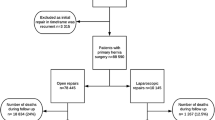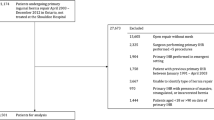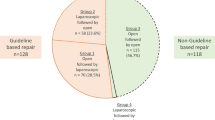Abstract
Purpose
The objective of this study was to assess data on inguinal hernia repairs (IHR) performed for recurrence over a 16 year period (2004—2019) in Spain.
Methods
A retrospective cohort study of 1,302,788 patients who underwent IHR from January 2004 to December 2019 was conducted. Data were extracted from the Spanish Minimum Basic Data Set (MBDS) of the Health Ministry database. The primary objective was to analyse the proportion of IHR performed by recurrence. As secondary objectives, we evaluated factors related to recurrent hernia (analysed by univariate analysis and multivariable logistic regression analysis) and trends in the recurrent case rate over the 16 year period.
Results
We identified 95,025 patients (7.3% of all IHR) who underwent surgery for recurrent inguinal hernia. Patients undergoing recurrent IHR were more likely to be male (OR 1.687, 95% CI 1.645–1.730), elderly (age > 74 years), and more complicated when they arrived in the operating room (gangrene OR 3.951, 95% CI 3.734–4.180; occlusion OR 1.905, 95% CI 1.853–1.960), and thus had more surgical site occurrences and related mortality. The proportion of IHR performed for recurrence has been dropping over the years (8.7% in 2004 vs. 6.5% in 2019, p < 0.005).
Conclusion
The rate of recurrent IHR in Spain (2004–2019) is 7.3%. Recurrent IHR correlates to emergent and complicated surgery and thus to a worst outcome. The trend of this 16 year period is of decreasing operated recurrent inguinal hernia. This is good news even though the improvement is slight and certainly insufficient. Establishing and optimising the rate of hernia recurrence is important for patients and for the health-care system.




Similar content being viewed by others
References
Simons MP, Smietanski M, Bonjer HJ et al (2018) International guidelines for groin hernia management. Hernia 22:1–165. https://doi.org/10.1007/s10029-017-1668-x
Amid PK, Shulman AG, Lichtenstein IL (1995) The Lichtenstein open “tension-free” mesh repair of inguinal Hernias. Surg Today 25:619–625. https://doi.org/10.1007/BF00311436
Decker E, Currie A, Baig MK (2019) Prolene hernia system versus Lichtenstein repair for inguinal hernia: a meta-analysis. Hernia 23:541–546. https://doi.org/10.1007/s10029-019-01897-w
Nordin P, Bartelmess P, Jansson C et al (2002) Randomized trial of lichtenstein versus Shouldice hernia repair in general surgical practice. Br J Surg 89:45–49. https://doi.org/10.1046/j.0007-1323.2001.01960.x
Sandblom G, Gruber G, Kald A, Nilsson E (2000) Audit and recurrence rates after hernia surgery. Eur J Surg 166:154–158. https://doi.org/10.1080/110241500750009519
Bay-Nielsen M, Kehlet H, Strand L et al (2001) Quality assessment of 26,304 herniorrhaphies in Denmark: a prospective nationwide study. Lancet 358:1124–1128. https://doi.org/10.1016/S0140-6736(01)06251-1
Köckerling F, Koch A, Lorenz R et al (2015) How long do we need to follow-up our hernia patients to find the real recurrence rate? Front Surg 2:1–5. https://doi.org/10.3389/fsurg.2015.00024
Murphy BL, Zhang J, Ubl DS et al (2019) Surgical trends of groin hernia repairs performed for recurrence in Medicare patients. Hernia 23:677–683. https://doi.org/10.1007/s10029-018-1852-7
Guillaumes S, Hoyuela C, Hidalgo NJ, Juvany M, Bachero I, Ardid J, Martrat A, Trias M (2021) Inguinal hernia repair in Spain. A population-based study of 263,283 patients: factors associated with the choice of laparoscopic approach. Hernia 5:1345–1354. https://doi.org/10.1007/s10029-021-02402-y
Barba R, Marco J, Canora J et al (2015) Prolonged length of stay in hospitalized internal medicine patients. Eur J Intern Med 26:772–775. https://doi.org/10.1016/j.ejim.2015.10.011
Barba R, Gonzalvez-Gasch A, Joya Seijo D et al (2018) Venous thromboembolism in patients with liver diseases. J Thromb Haemost 16:2003–2007. https://doi.org/10.1111/jth.14255
Sánchez-Muñoz G, De Andrés AL, Jiménez-García R et al (2016) Time trends in hospital admissions for bronchiectasis: analysis of the Spanish national hospital discharge data (2004 to 2013). PLoS One 11:1–15. https://doi.org/10.1371/journal.pone.0162282
Mehta A, Hutfless S, Blair AB, Dwarakanath A, Wyman CI, Adrales G, Nguyen HT (2017) Emergency department utilization and predictors of mortality for inpatient inguinal hernia repairs. J Surg Res 15(212):270–277. https://doi.org/10.1016/j.jss.2016.12.012
Ramsay G, Scott NW, Jansen JO (2020) A 19 year population-based cohort study analysing reoperation for recurrence following laparoscopic and open inguinal hernia repairs. Hernia 24:793–800. https://doi.org/10.1007/s10029-019-02073-w
Murphy BL, Zhang J, Ubl DS, Habermann EB, Farley DR, Paley K (2018) Trends of inguinal hernia repairs performed for recurrence in the United States. Surg (United States) 163:343–350. https://doi.org/10.1016/j.surg.2017.08.001
Ansaloni L, Coccolini F, Fortuna D et al (2014) Assessment of 126,913 inguinal hernia repairs in the Emilia-Romagna region of Italy: analysis of 10 years. Hernia 18:261–267. https://doi.org/10.1007/s10029-013-1091-x
Palser TR, Swift S, Williams RN et al (2019) Variation in outcomes and use of laparoscopy in elective inguinal hernia repair. BJS open 3:466–475. https://doi.org/10.1002/bjs5.50158
Maneck M, Köckerling F, Fahlenbrach C et al (2020) Hospital volume and outcome in inguinal hernia repair: analysis of routine data of 133,449 patients. Hernia 24:747–757. https://doi.org/10.1007/s10029-019-02091-8
Köckerling F, Maneck M, Günster C et al (2020) Comparing routine administrative data with registry data for assessing quality of hospital care in patients with inguinal hernia. Hernia 24:143–151. https://doi.org/10.1007/s10029-019-02009-4
Kevric J, Papa N, Toshniwal S, Perera M (2018) Fifteen-year groin hernia trends in Australia: the era of minimally invasive surgeons. ANZ J Surg 88:E298–E302. https://doi.org/10.1111/ans.13899
Ministerio de Sanidad y Consumo. Gobierno de España. Registro de Actividad de Atención Especializada. RAE-CMBD - Solicitud de extracción de datos. https://www.mscbs.gob.es/estadEstudios/estadisticas/estadisticas/estMinisterio/SolicitudCMBD.htm . Accessed 22 Feb 2022
Gobierno de España. Agencia estatal Boletín Oficial del Estado. Real Decreto 69/2015, de 6 de febrero, por el que se regula el Registro de Actividad de Atención Sanitaria Especializada. BOE núm. 35, de 10/02/2015: p 10789–10809. https://www.boe.es/eli/es/rd/2015/02/06/69/con . Accessed 22 Feb 2022
Ministerio de Sanidad Consumo y Bienestar Social. Manual de definiciones y glosario de términos. Serie histórica CMBD-RAE . Hospitales de agudos. Actualización marzo 2021. https://pestadistico.inteligenciadegestion.mscbs.es/publicoSNS/S/rae-cmbd. Accessed 22 Feb 2022
Ministerio de Sanidad Consumo y Bienestar Social. Portal Estadístico. Datos de población. https://pestadistico.inteligenciadegestion.mscbs.es/publicoSNS/S/poblacion. Accessed 13 Nov 2020
Armitage P (1955) Tests for linear trends in proportions and frequencies. Biometrics 11:375. https://doi.org/10.2307/3001775
Jenkins JT, O’Dwyer PJ (2008) Inguinal hernias. BMJ 336:269–272. https://doi.org/10.1136/bmj.39450.428275.AD
Zendejas B, Ramirez T, Jones T et al (2013) Incidence of inguinal hernia repairs in Olmsted county, MN: a population-based study. Ann Surg 257:520–526. https://doi.org/10.1097/SLA.0b013e31826d41c6
Kald A, Nilsson E, Anderberg B et al (1998) Reoperation as surrogate endpoint in hernia surgery: a three year follow-up of 1565 herniorrhaphies. Eur J Surg 164:45–50. https://doi.org/10.1080/110241598750004940
Magnusson N, Nordin P, Hedberg M, Gunnarsson U, Sandblom G (2010) The time profile of groin hernia recurrences. Hernia 14:341–344. https://doi.org/10.1007/s10029-010-0648-1
Haapaniemi S, Gunnarsson U, Nordin P, Nilsson E (2001) Reoperation after recurrent groin hernia repair. Ann Surg 234:122–126. https://doi.org/10.1097/00000658-200107000-00018
Köckerling F (2017) Data and outcome of inguinal hernia repair in hernia registers—a review of the literature. Innov Surg Sci 2:69–79. https://doi.org/10.1515/iss-2016-0206
Kjaergaard J, Bay-Nielsen M, Kehlet H (2010) Mortality following emergency groin hernia surgery in Denmark. Hernia 14:351–355. https://doi.org/10.1007/s10029-010-0657-0
Goicoechea Salazar J, Rodriguez Herrera J, Jiménez Romero MR TEJ (2020) Sistema de detección de errores del CMBD. https://www.sspa.juntadeandalucia.es/servicioandaluzdesalud/sites/default/files/sincfiles/wsas-media-pdf_publicacion/2020/SDER_CMBD2008.pdf. Accessed 24 Feb 2022
Acknowledgements
The authors thank the Spanish Ministry of Health, Social Services and Equality of Spain for permission to obtain the data.
Author information
Authors and Affiliations
Corresponding author
Ethics declarations
Conflict of interest
The authors state that they have no conflict of interest.
Ethical approval
Because only anonymised public data, requested from the Ministry of Health, Social Services and Equality of Spain, was analysed, ethical approval was not necessary.
Human and animal rights
This article does not include any studies with animals performed by any of the authors.
Informed consent
Because only anonymised routine data was analysed, informed consent of the patients is not required.
Additional information
Publisher's Note
Springer Nature remains neutral with regard to jurisdictional claims in published maps and institutional affiliations.
Rights and permissions
About this article
Cite this article
Guillaumes, S., Juvany, M. Inguinal hernia repairs performed for recurrence in Spain: population-based study of 16 years and 1,302,788 patients. Hernia 26, 1023–1032 (2022). https://doi.org/10.1007/s10029-022-02630-w
Received:
Accepted:
Published:
Issue Date:
DOI: https://doi.org/10.1007/s10029-022-02630-w




